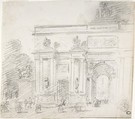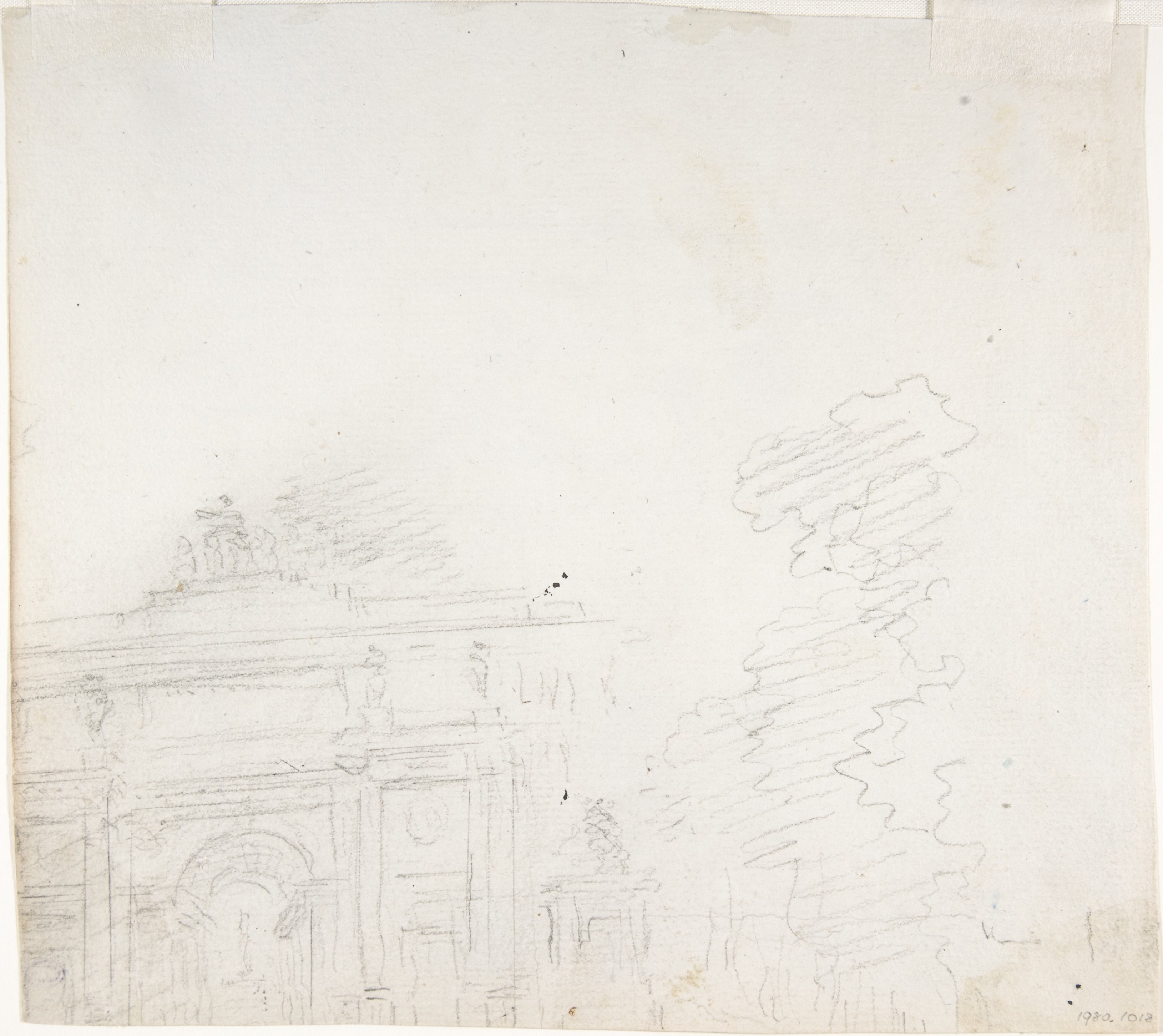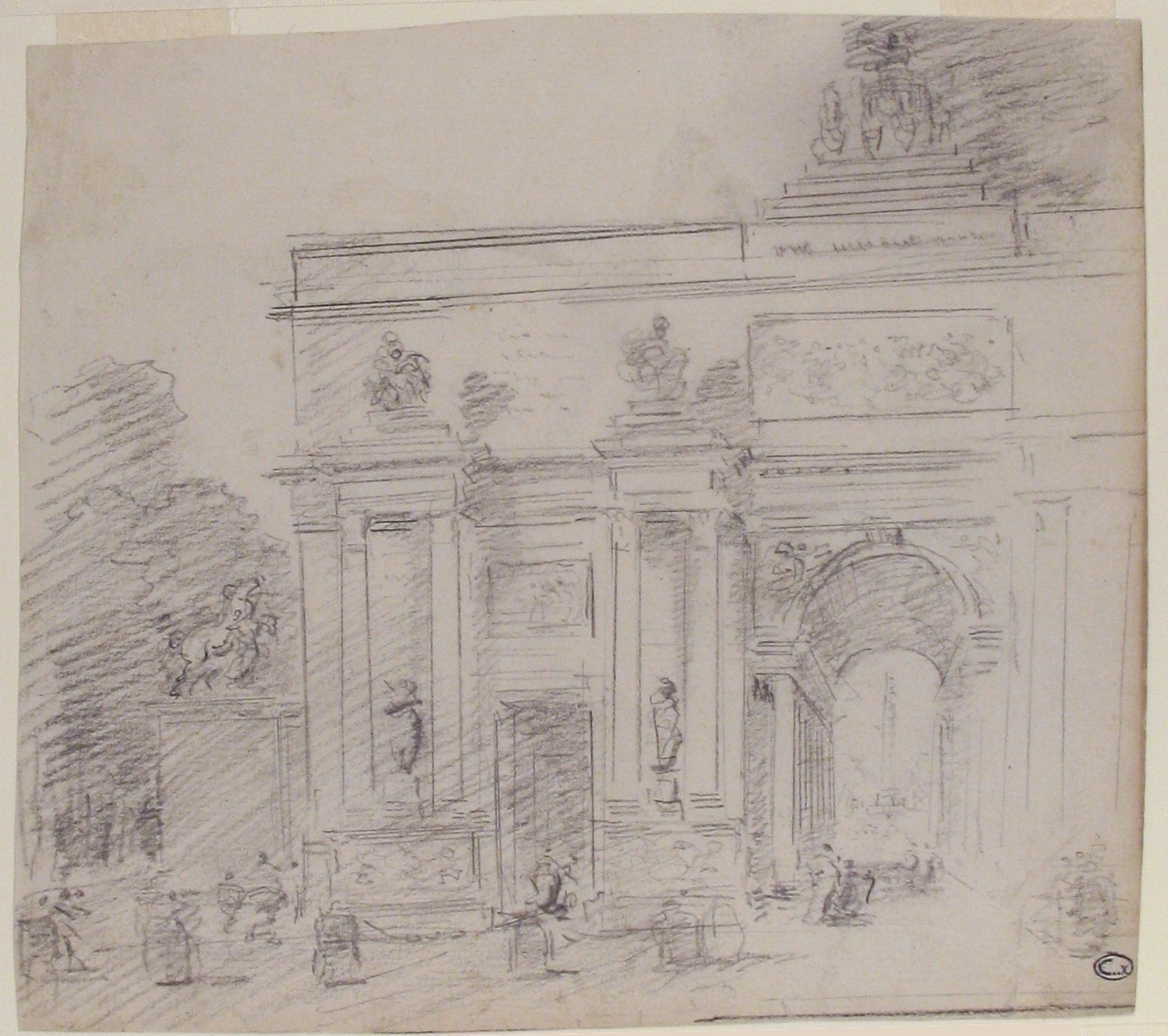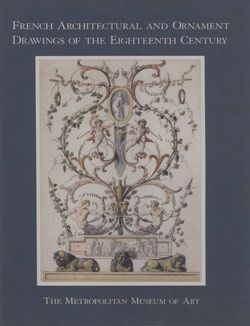Study for a Triumphal Arch (recto); Alternate Study for a Triumphal Arch (verso)
Hubert Robert French
Not on view
This drawing was originally part of an album that contained 152 sketches made by Hubert Robert between 1775 and 1806 (Cailleux, 1979). The album, known as the Ernest May album, was a book of blank pages onto which drawings were pasted. Some of the sketches had to be cut to fit the size of the album. In the case of the Met’s drawing, the cropping of the arches on both recto and verso are indications that the sheet has been cut down. It should be noted that our sketch is one of only two in the album to document the urban evolution of Paris (the other being a view of the demolition of the Bastille, op. cit., no 119).
After his return from his Italian sojourn in 1765, Robert prefered the medium of black chalk for depicting landscapes and figures in his sketchbooks, as well as for his initial ideas for compositions. Despite the fact that the right side of the design is only summarily indicated, the Met’s drawing served as the model for a large and highly finished watercolor, now in a French private collection.
Marianne Roland Michel in 1972 was the first scholar to link the Met’s drawing with the project for the redesign of the Place de la Concorde. Mary L. Myers in 1991 further described the contest, which was launched in 1799 with the aim of glorifying Napoleon’s military conquests with the placement of a triumphal arch at the top of the Champs-Elysees, a second at the entrance of the Tuileries gardens, and an obelisk in the square now known as the place Vendome. Myers rightly drew attention to the role of equine sculptures in Parisian public spaces and events. For example, the Marly Horses by Guillaume Coustou (1677-1746) were installed at the entrance to the Champs-Elysées in 1795, and the ancient horses that Napoleon had removed from Saint Mark’s basilica in Venice found a place atop the Arc de Triomphe du Carrousel. In the Met’s drawing, one finds the motifs of both the Marly Horses and the Horses of Saint Mark’s used to adorn a triumphal arch, but it would be hasty to conclude therefore that Robert had participated in the contest. The artist was not registered to present a project, but it would not have been out of character for him to put his ideas down on paper to informally share with friends or colleagues.
Jean Cailleux in 1979 had recalled the links drawn by André Corboz between the triumphal arches of Robert's late years and the ideal representations of the visionary architect Étienne-Louis Boullée (1728-1799). It is also worth pointing out the echoes, in designs like this one, of Robert’s earlier studies made in Rome after ancient triumphal arches, such as those of Constantine and Septimius Severus, as well as his designs, dating to around 1760, of imaginary ancient arches inspired by Baroque monuments like the casino of the Villa Sacchetti or the Trevi fountain. Moreover, in the Roman sketchbook of around 1763 belonging to the Pierpont Morgan Library & Museum, Hubert Robert had already sketched an openwork colonnade supporting a pediment with a quadriga at its summit (acc. no. 1958.5, fol. 16).
Robert’s passion for architecture ancient, modern, and contemporary is well known. It is an obsession we see frequently in his paintings of the 1790s, especially in his creative visualizations of the lighting and installation of the Louvre’s Grande Galerie (Paris, Musée du Louvre, acc. no. RF 1975-10, RF 1952-15 ) which have led art historians to propose that he also had a concrete role in the architectural projects for the building. This hypothesis has now definitively been ruled out, but one can still assert that Robert's work was nourished by his friendships with Charles de Wailly (1730-1798) and Jean-Augustin Renard (1744-1807), the architects charged with the renovation of the Grande Galerie. A similar situation of intellectual and creative engagement may have been at play in this drawing of the triumphal arch, as the winners of the design contest, Jean-François-Thérèse Chalgrin (1739-1811) and Charles Percier (1764-1838), were also both friends of the artist.
A parallel sketch in black chalk, also made by Robert around 1800, represents his ideas for an ideal museum (Le Palais des Antiquités, Orléans, Museum of Fine Arts, acc. no. 1070-D), and is likewise preparatory for a watercolor in a private collection (Mehdi Korchane in cat. exh. Entre Lumières et Romantisme : dessins du musée des Beaux-arts d'Orléans, no. 90). Thus, we can understand both the New York and Orléans sketches as studies for watercolors of imagined architectural projects, but other questions remain unanswered : were the watercolors made for his own use, for the market, or for a special commission?
Sarah Catala (August, 2017)
This image cannot be enlarged, viewed at full screen, or downloaded.
This artwork is meant to be viewed from right to left. Scroll left to view more.






